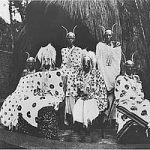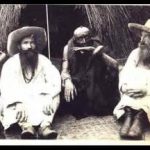The White Fathers’ Mission in Rwanda III
An Overview III
Possession of cows was the first step on the social ladder that led into the land and cattle-owning class. A garagu’s humiliating duties, the nightwatcht bringing beer, accompanying his lord on journeys and clearing his nightsoil were compensated by ownership of cattle and freedom from uburetwa. A socially acceptable outlet for feelings was a joking relationship with the shebuja in which mutual insults were exchanged. Around the Tutsi household the peasant was able to learn the sophisticated language and ways of the ruling class, and keep in touch with intrigues. The ladder was in reality narrow and a shebuja was more likely to sleep with his clients’ wives and daughters than accept his garagu’s sons as husbands for the Tutsikazi of the house. Enough did pass up it for a garagu to cherish the illusion that his humiliations were the first painful steps to ennoblement and riches. But, confronted with the elaborate paraphernalia of court life, with its nuanced poetry and measured disdain, the peasant outside Tutsi patronage readily came to believe that, apart from being physically smaller and materially poorer, he was intellectually and morally inferior.
Although the prevailing ideology accentuated an ethnic distinction between Hutu and Tutsi, the underlying class structure was more complex. The Tutsi were divided into a ruling minority of a few dozen families owning herds, of tens of thousands of cattle, and the majority with only one hundred or so. Many poor Tutsi had less cattle than rich Hutu who, themselves, were a minority on top of the main body of the peasantry. At the bottom of the scale was an indeterminate number of journeymen despised by all and little better than the Twa outcasts. Rich Hutu were able to obtain labour from clients, two clays out of five as in uburetwa, by giving impoverished peasants a hoe. In the north, the abakonde had permanent clients on their land. Under such circumstances, religion might justly be called the opium of the Hutu; while Hutu hero-spirits in the imandwa pantheon ruled in concert with a classless divine king, the genitals of defeated abahinza adorned the Nyiginya dynastic drum, Kalinga, and the Hutu were turned into serfs.
In the north-east, though, religion was more the expression of local dissidence. Nyabingi was probably a late eighteenth century ‘queen’ of Ndorwa; after the kingdom had been destroyed by repeated invasions a cult to her spirit grew up with mediums who broadcast her alleged wishes. The spirit was known as Mugore, the Lady. Cattle traders from Gisaka made contact with Nyabingi mediums in Uzinza and claimed on their return to be possessed by a powerful foreign mandwa: This innovation gained them the opposition of the Lyangombe cult officials since the new mediums rallied opposition against Tutsi rule and had a considerable following amongst the peasantry: When they began collecting tribute to the detriment of the mwami’s ikoro, an expedition was mounted against them.
By manipulating the traditional symbols of kingship and claiming supernatural powers, the Nyabingi priestesses remained a potential focus for opposition to the Rwandan mwami throughout the nineteenth century. Later obsservers described them as ‘une autorité révolutionnaire, un État dans l’État; elle abuse de la haine née du « muhutu » pour tout pouvoir établi et fait tourner cette haine à son profit’. Their main centre remained Mpororo and the northern marches of the Rwandan State where Tutsi control was sporadic, little more than infrequent raids and sorties from isolated residences. Rutajira Kijuna (c.1870) was accorded the royal greeting, kasinje’ and given the praise names ‘Rutatangira omu Muhanda’, she who is unstoppable, and ‘Akiz’abantu’, saviour of the people. Political organisation aped that of the mwami; mediums maintained a number of ‘temples’ and clients, abagirwa, who shared in the leading priestess’ spiritual powers. Like abahinza, they gave audienceS from behind a partition and, it was said, they could perform miraculous cures. Unlike the Lyangombe mediums whose mandwa served the established order at court, Nyabingi shamans moved freely over the hills offering the Hutu a genuine contestation of the Rwandan order.
It was during the long and militarily spectacular reign of mwami Rwabugiri that the contours of the Rwanda seen by Europeanes were formed. In a series of over sixteen major campaigns, lasting; from 1860 – 1895, Rwabugiri raided as, far north as Nkole, into south Kivu and onto the island of Idjwi, and into northern Burundi, while keeping hold of Gisaka and the east. This incessant military activity produced a supply of cattle and postures new to keep royal favourites well rewarded and threatening nobles fully occupied. With the Abega providing four successive Queen mothers in a row, Rwabugiri inherited both inter and intra-lineage tensions amongst the leading Tutsi families; these he kept in check by terror and selective assassination By taking over the hereditary principalities of mudererd chiefs, and multiplying the number of royal residences, Rwabugiri’s reign took on the character of an absolute monarchy.
The need to provision his ingabo and newly formed residences and to recruit troops for new-campaigns dictated a policy of co-operation with Hutu authorities. A Tutsi ambassador was sent to the kingdom of Busozo to demand a mere annual tribute of honey; he never se foot in the region. Bukunzi sent a boy from the Yombo lineage and a girl from the Chuku. They were known as the king’s pillows, imisego y’umwami; the latter became the mwami concubine while the former was killed and his blood used for ritual purposes. The first fruits from the little kingdom of Bumbogo were sent to Rwabugiri who sent back a hoe. Such kingdoms retained their autonomy. Agents, ibisonga were dispatched to the Northern provinces to reside and collect tribute but more often than not they were driven away.
It is broadly true that the mwami’s effective rule decreased with distance from the old nuclear kingdom of the sixteenth century, but the political map is best described as a temporal and spatial patchwork. The prestige of Rwabugiri would have assured successful collection of ikoro while he remained at a residencee; when he left the people seem to have been refractory and rebellious; to his representatives. The mwami was not even safe from attack at Save in the Rwandan heartland.
Rwabugiri’s policy of breaking the great Tutsi families; and relying on ennobled Hutu favourites and Twa spies earnt him the image of ‘bon pour le peuple, terrible pour les Batutsi’ ; the average lite expectancy of Tutsi given political commande over Rwanda’s twenty or so provinces was about ten year. Like a northern Shaka, Rwabugiri forged the modern Rwanda through a mixture of military skill, shrewd politics and utter ruthlessness, though part of his power came from his suscess in monopolising long-distance trade.
European trade goods first appeared in the country in the reign of Yuhi Gahindiro at the beginning of the nineteenth century. Rwabugiri did not: underestimate their importancy, ivry and skins were taken east through Gisaka to his agent, Chief Runyange of Mirenge province, who exchanged them for cloth and trade goods coming from Bukoba. An attempt by chief Kabaka of Gihunya province to divert trade led to his assassination. The mwami’s foreign goods included a gun and an umbrella; the bulk of cloth was handed on to nobles who paid for it in cattle added to the royal herds.
Yet, despite a meeting with the Arab slaver; Rumaliza; on the Ruzizi river, Rwabugiri spurned the possibilities of the slave trade. Although a slave market graw up at Kivumu for caravane from eastern Kivu, visiting Arabe were attacked or poisoned on the mwami’s orders. The Tutsi seem to have frowned on the slave trade and the selling of women and children only flourished in times of dire famine and did not involve the nobility. At its peak the trade probably did not amaunt to more than 1,000 Rwandans per year taken into Tanganyika territory.
The Hutu had a number of important markets .At Kamembe in the south-west, goats and cattle from Rwanda were exchanged for iron hoes manafactured by the Bunyabungo. Rwerere, at the foot of the volcanoes was, a major centre for tobacco and fibre bracelets, ubutega, while salt from distant Katwe came down to markets in Buberuka. These local markets were not under the mwami’s direct control, though specialist produce of a region, the important items of exchange, were demanded by the court in annual ikoro; Rwerere and, Nyundo markets, for example, were taxed by clan heads. Mwami Musinga set up a market at Gitwe
(1896) to control the importation of cloth from Bujumbura.
With the exception of royal residences where large numbers of Hutu had to be in attendance, markets provided one of the few centrers at which Hutu from different hills could meet together and exchange news. They were, at the periphery of the Rwandan State. For the northern Hutu the other principal centres were the courts, of the Nyabingi prophetesses. A ‘Queen of Ndorwa’ became sufficiently powerful for Rwabugiri to engineer her death at the hands; of the chief of Bufumbira, and later to find it politic to deny all responsibility. The tradition states that her severed head upbraided the mwami, a nice allegory for cult figures who arose hydra-like at intervals until the 1920s. Stanley in 1876 spoke of a priestesst ‘Wanyavingi’ and called her ‘Empress of Rwanda’. Emin Pasha gave another interesting account of such prisatess in 1891.
“The Queen of Mpororo…said to be a woman named Njavingi….has never been seen by anyone, not even her own subjects. All that; they ever get to know of her is a voice heard behind a curtain of bark-cloth. Such theatrical practices, have gained for her, throughout Karagwe, Nkole etc, the reputationl of a great sorceress.”
The threat of Nyabingi was only fully to be realised in the colonial period.
Rwabugiri’s most immediate problems lay closer to home in the corporate powér of the abiru who controlled the succession: Some were sent to distant fiefs; and others; murdered until their power was broken. Their ritual prohibitions were; then ignored in the selection of the mwami’s successor, Rutalindwa. In Rwabugiri’s cavalier treatment of tradition, as Gravel wrote of Gisaka politics, ‘sheer powe…determined the rules’.
The mwami’s first encounter with Europeans is alleged to have taken place on Lake Edward during the Nkole campaign of 1892-1893. He was impressed by their use of written messages which, it is said, he interpreted as proof of an occult power that allowed Europeans to read people’s thoughts and words. He is said to have invited them to come to Rwanda to manafacture cloth. A skirmish with Von Gotzen’s troops in 1894 must have changes this first favourable impression. News of the Europeans cannon, umuzinga, reached the king who sent messengers to Karagwe to consult the neighbouring Haya chiefs, thought to have more experience of the Whites. News came back that the Europeans were invincible and should be greeted in a friendly fashion but the court was divided and cows were sacrificed to decide whether the kingdom needed the sacrificial death O r an umutabazi or an offensive war. Traditions; maintain that the final decision was that the Whites should be greeted peacebly but the mwami shielded from their supernatural powers.
Rutalindwa’s mother was dead when he was appointed heir in 1889 and a substitute Queen Mother Kanjogera, was selected from the Bega. This was not only contrary to all precedent but unwise; Kanjogera, had a son of her owm and enjoyed the support of the powerful Bega statesmen; Kabare and Ruhinankiko. Within a year of Rwabugiri’s death in 1894, Rutalindwa was dethroned in a Bega coup and Musinga made mwami. By flouting tradition Rwabugiri had delivered the kingdom into Bega hands. The young Rutalindwa suffered a crushing defeat at the hands of the Belgians at Shangi. Humiliated and with his abiru supporters depleted by assassinations, he was easzy prey for the prepared Bega.
When the Germans marched into Rwanda in 1897 Musinga and Kanjogera had barely been in power a few weeks. Meeting with Mpamarugamba, head of the imandwa who posed as the mwami, the Germans offered protection against the Belgians, support for the king, and left the Tutsi in no doubt as to their military might. Only three years later was it realised that Mpamarugamba was an imposter. The offer of support; was timely, followers of Rutalindwa had risen in revolt and the Teke sub-clan in northern Rwanda took the opportunity to drive out the Tutsi sparking off waves of Hutu attacks. A leader, Bilegeya, arose claiming to be a son of Rwabugiri but the northern revolt, fragmented and uncoordinated was quickly quelled by Musinga’s regiments.
The Bega consolidated their position by killing Nyiginya nobles. The situation was intrinsically unstable witht a Nyiginya mwami in a Bega- dominated court, a usurpen brought to power after the suicide of the legitimate heir. Rwabugiri’s brilliant career as a warrior-herd lay behind and the mwami’s effective area of jurisdiation had already shrunk since his father’s glorious days. Poised on Rwanda’s borders were Europeans whose military might was uncontested and whose supernatural powers might be a grave threat to the realm.
The murderous court politics and general Tutsi disarray only touched the northern Hutu where isolated settlers could be chased out without fear of reprisal. The fate of the Central Rwanda Hutu was too closely tied to the ruling class through ubuhake for revolt. Yet there were still Hutu who owned cattle in their own right and resisted demande for uburetwa.The term umuhinza came to mean ‘an opponent of the mwamit’ so it may be imagined that the autonomous Hutu kingdoms kept alive memories of resistance. The Hutu lineages were never entirely shattered by ubuhake; they retained their local history and veneration of their ancestral spirits; in opposition to the growing strength of the Tutsi households with their cluster of retainers.
On the eye of missionary penetration, the Hutu masses were suffering a process that might be called ‘infeudation’ and that had gathered momentum in the nineteenth century. Marc Bloch’s oomprehensive definition of feudal society does not seem inappropriate to this part of Rwanda. “A subject peasantry; widespread use of the service tenement ( i.e: the fier) instead of salary, which was out of the question; the supremacy of a class of specialised warriors; ties of obedience which bind man to man…fragmentation of authority leading inevitably to disorder; and in the midst of al this, the survival of other forms of association, family and state”.
Since the term ‘fief’ comes from a Germanic root meaning cattle, it is suitable for the particular modalite of Rwandan clientehip, the recording of a grant of benefice by transfer of cattle.
On the other hand, the loose use of the feudal model applied to African societies has comee in for soma weighty criticism. Redmayne was the first to suggest that comparison with other African societies might be more fruitful than slavish application of European terminologiy. Goody wanted analysis: ‘with less worn counters, with more operational concepts’ than ‘feudalism’. Beattie later found the concept of feudality inadequate as a description of the Nyoro States. De Heusch, following Mair, preferred to place feudalism in the broader category of clientship States. The most telling part of Goody’s recent argument is the disparity between the raised value of land in Europe, created by feudal technology, and the low-yield land of Africa. African technology was too underdeveloped and land too poor to support feudalism.
Two Major distinctions are made in these critiques: on the one hand; feudalism Ganshof’s socio-legal sense as to body of institutions regulating the obligations of obedience and service- mainly military service – on the part of the free man (the vassal), towards; another free man (the Lord), and the obligations of protection and maintainence on the part of the lord with regard to his vassal, on the other, feudalism as a political and governmental category characterised by a type of landholdine and relationship between monarchy and nobility. Feudalism in this second sense could take on a strict historicist meaning as the unique sequence of social changes int Western Europe, and so preclude all debate, Beattie’s discussion of feudalism and Nyoro kingship amounts to to this. Kagame similarly points to the existence of an absolute monarchy in nineteenth century Rwanda as a reason for rejecting the term ‘feudal’, like Maquet, though, he would countenance it in the context of ubuhake in the socio-legal sense of ‘Contrat de Servage’.
Pared to their essential, arguments either spurn the socio-legal definition as too broad to be useful or; taking a ‘historicist’ position, use a definition too precise to fit the history of any African State. For feudal society was not the remit of any breakdown of centralisecl government in the African context, but more like a stage in the growth of centralised states from clan and lineage based societies. Finally how could it be gainsaid that, if land was not a scarce and coveted resource in pre-colonial Africa, the ‘fief’ had widely different political significance on the two continents?
Granting all this; there is need to make an exception for Rwanda. In this case, a surfeit of fine scholarly distinctions can end up by obscuring the particular social texture of a State and the dynamics of its development. For example, the difference between political power, administrative office and clientship are convenient categories for the orderly mind but separate functions that may have been intimately related in practice. D’Hertefelt points out how this was the case in Rwanda:
« Ces deux structures politiques et l’institution de clientèle étaient correlatives. Les fonctions politiques aidaient les Tutsi à accroître le nombre de leurs clients et la structure de clientèle leur permettait d’obtenir des fonctions politiques et de les conserver. Les relations entre le seigneur et le client constituaient un modèle pour les relations entre les gouvernants et leurs sujets ».
Political office implied rights in land and rights to military service; this was what gave the Rwandan polity, its particular quality. Neither is it true that in Rwanda, with its high population density, extensive banana groves and shortage of pesture land, the land was not coveted and scarce.
Moreover; after the absolutism of Rwabugiri’s reign in which the tendency for benefices to become hereditary fiefs was checked, conflict between a ‘centrifugal’ nobility and a centralising monarchy was an important element in political change. If ‘feudal’ implies a dynamic political sense of an internal tendency within Rwandan society towards an equilibrium in which the Tutsi military aristocracy ruled through a chain of client relationships, cheeked on one side by the State, and on the other by the Hutu clans then it has heuristic value. Equally, as a static description of a social orders the parallels with English Norman feudalism are too striking to be ignored. Rwanda was a complex, pyramid of client ship ties headed by the king; the early, type of vassalage was military service ingabo; a garagu passed through a formal ritual of subordination, and exchanged service for protection, while the relationship was recorded by benefice of movable property over which the peasant had usufruct rights.
What particularly characterised the Rwandan State was not the existence of autonomous clan-lands, nor a kingship which stood over and against a powerful nobility, but that institutions, found in other interlacustrine kingdoms had, as it were, following their own internal dynamic and developing Under the pressure or conflicts within the entire Rwandan territory, achieved a greater degree of elaboration to the point of luxuriance. The Tutsi class had become almost a closed caste. The mwami, more than a Kabaka or Mukama had elaborated the kingship into a complex rituel aseity. The rich and mystifying ideology 0f divine kingship and the hierarchy of clientship ties had grown apace to cement the stratification of soeiety and counteract the ‘centrifugal’ tendencies of powerful nobles and Hutu lineages. The mwami, source of justice promoter of the lowly, was the negation of the stratified society over which he ruled.
“Le mwami contribue pour une bonne part a cette fusion des races; et aux changements brusques de condition » wrote de Lacger. ‘La cour, dit-on,` foisonne de parvenus’.
The kingship never achieved a monopoly of religious symbolism but its identification with Imana made of the mwami an occult presence in the realm, the projected father-image of the Hutu. Reared in an authoritarian, patrilocal society, Rwandans thought of the king not as a Nyiginya Tutsi struggling to stay in power, but, as a transcendental source of creativity and authority: No-one would have faulted Father Brard when he wrote home in 1900: “C’est une grande insulte de dire que le roi et sa mere sont des batousi, ils sont rois (abamis)”.
https://uk.amateka.net/the-white-fathers-in-rwanda-an-overview-iii/Model CitizenshipAn Overview III Possession of cows was the first step on the social ladder that led into the land and cattle-owning class. A garagu’s humiliating duties, the nightwatcht bringing beer, accompanying his lord on journeys and clearing his nightsoil were compensated by ownership of cattle and freedom from uburetwa. A...BarataBarata rpierre@ikaze.netAdministratorAMATEKA | HISTORY OF RWANDA





